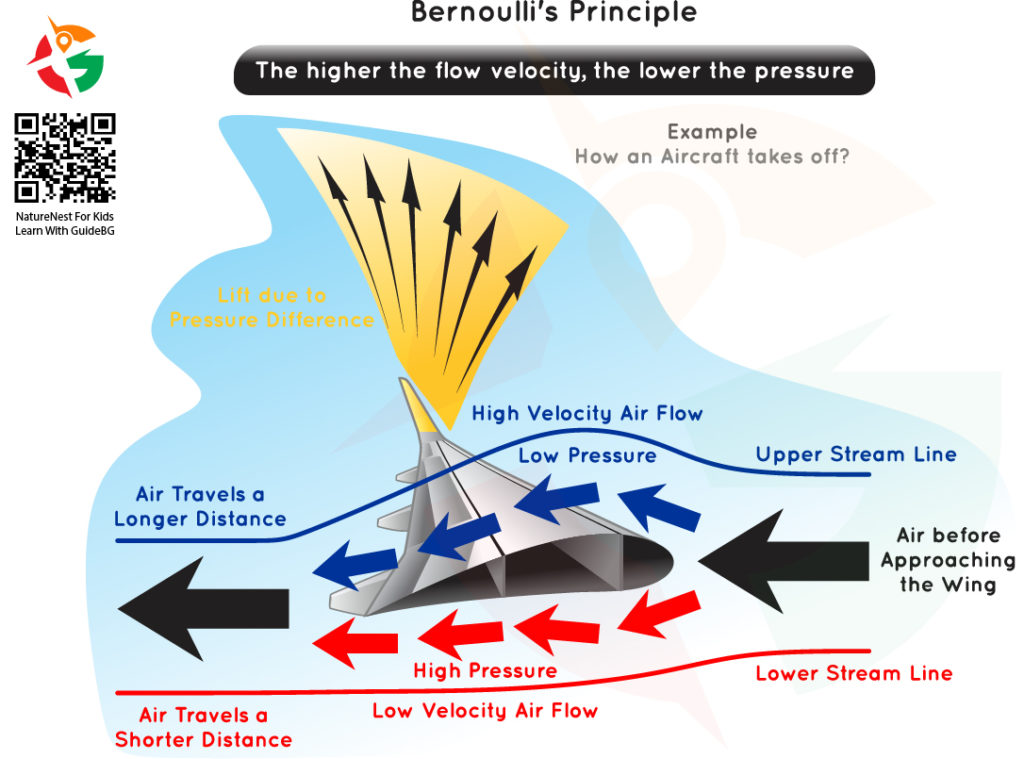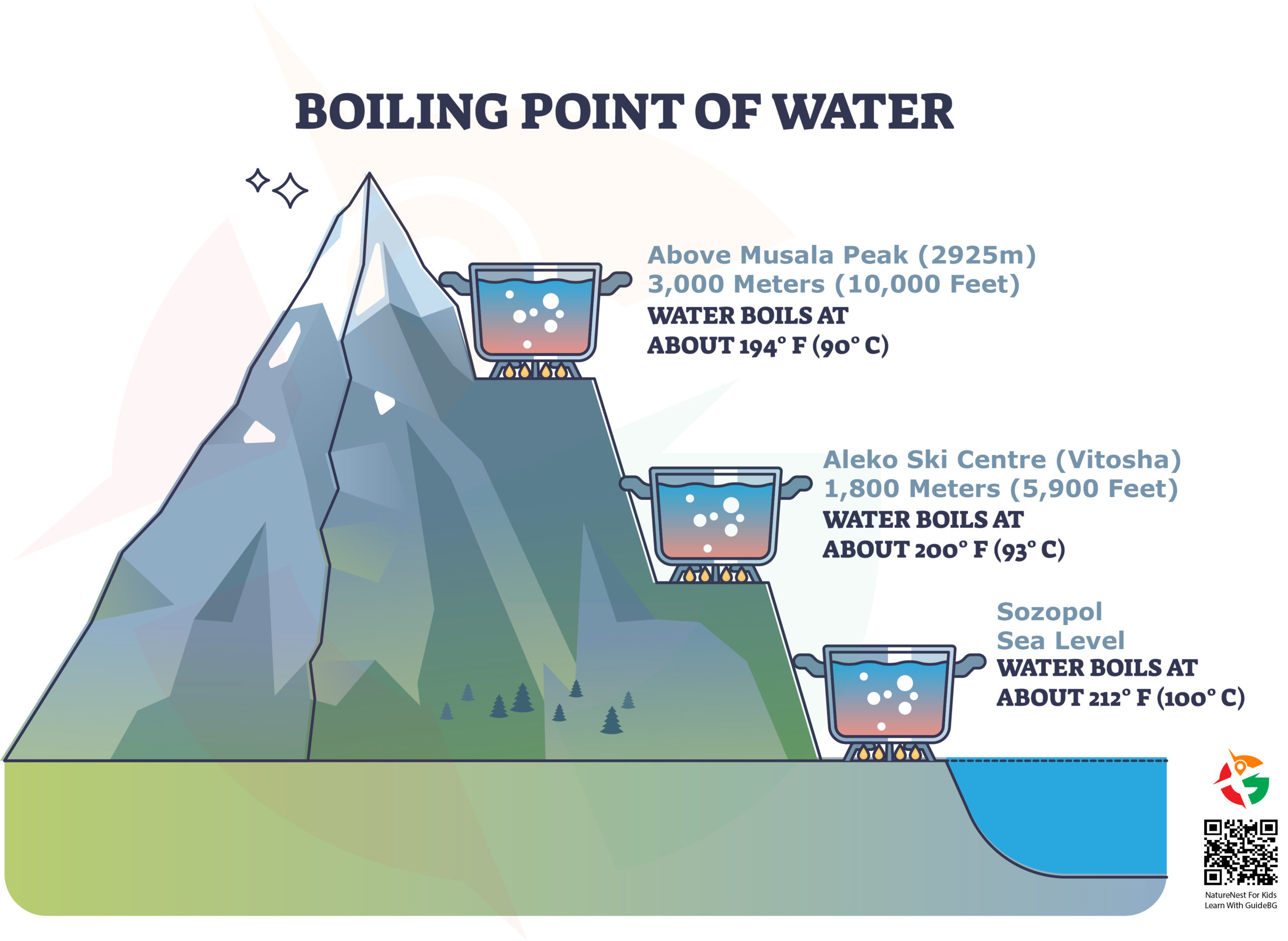Have you ever gazed up at the sky, marveling at a bird in flight or an airplane soaring above, and wondered how they do it? Flying is one of humanity’s oldest dreams, thanks to excellent physics. Let’s dive into the fascinating world of flying and wings, exploring two fundamental principles that make it all possible: Bernoulli’s principle and the Coanda effect. Get ready to have your mind lifted off the ground!
Bernoulli’s Principle: Unlocking the Secrets of Lift
Diving deeper into the wonders of flying, let’s spotlight Bernoulli’s principle, a cornerstone concept that acts like an invisible hand guiding objects through the air. This principle may seem like magic, but it’s grounded in the everyday behavior of fluids, including the air around us. To understand its power, imagine a simple experiment: blowing across the top of a paper strip hanging off the edge of a table. Instead of fluttering away, the paper lifts towards the airflow. This phenomenon, where the paper rises as you blow over it, directly demonstrates Bernoulli’s principle in action, illustrating a fundamental truth: a fluid in motion exerts less pressure than it does at rest.

Angle of Attack
The angle of attack is a fundamental concept in aerodynamics that refers to the angle between the chord line of a wing or airfoil and the direction of the oncoming airflow. The chord line is an imaginary straight line connecting the leading and trailing edges of the wing. In simpler terms, the angle of attack determines how steeply a wing slices through the air. This angle is crucial because it significantly affects the lift generated by the wing.
Increasing the angle of attack to a certain point increases the lift, which is essential during takeoff or climbing. However, exceeding this optimal angle can lead to a stall, where the wing suddenly loses much of its lift due to airflow separation, potentially causing the aircraft to lose altitude. Pilots adjust the angle of attack through the aircraft’s controls to maintain the desired balance of lift, drag, and speed, especially during critical phases of flight like takeoff and landing.
How Bernoulli’s Principle Powers Flight and Flying
When applied to flight, Bernoulli’s principle helps explain the lift that keeps birds, planes, and other flying objects airborne. Airplane wings are engineered with a specific shape, known as an airfoil, which causes air to move faster over the top surface than the bottom. According to Bernoulli’s principle, an increase in speed on the top side leads to decreased pressure. Since the pressure on the bottom of the wing remains relatively higher, this difference creates an upward force, or lift, propelling the plane into the sky.
The Intricacies of Airfoil Design
The airfoil design is no mere coincidence but a product of meticulous engineering that harnesses Bernoulli’s principle to the fullest. The wing’s curvature and angle are tailored to optimize the airspeed differential, maximizing lift while minimizing drag. This delicate balance allows aircraft to take off, maintain altitude, and land smoothly.
Real-World Applications and Beyond
Bernoulli’s principle isn’t limited to the realm of aviation. It finds applications in various fields, from sports, where it helps curve a soccer ball, to automotive design, improving vehicle aerodynamics. Moreover, the principle is fundamental in operating many devices, from simple garden sprayers to sophisticated engine carburetors, illustrating its versatility and importance in nature and technology.
The Coanda Effect: Shaping the Path of Flight
Venturing further into the aerodynamic forces that govern flight, the Coanda effect emerges as a pivotal phenomenon, guiding how air interacts with the surfaces it encounters. This effect, named after Romanian inventor Henri Coanda, who first identified it in the early 20th century, describes how a fluid (like air or water) tends to “cling” to and follow the contour of a curved surface, even when the surface curves away from the initial direction of the fluid flow.

High-Velocity Airflow
High-velocity airflow refers to the rapid movement of air relative to an object (like an airplane wing) or the ground. This concept is pivotal in achieving and maintaining lift. According to Bernoulli’s principle, the pressure decreases as airflow velocity increases over a wing’s top surface. Compared to the higher pressure below, this decrease in pressure above the wing creates lift, which is essential for flight.
High-velocity airflow is not only about speed but also about the airflow quality around the airfoil. Smooth, uninterrupted airflow (laminar flow) is more efficient, producing less drag and allowing for more effective lift than turbulent flow, which can increase drag and reduce lift. Engineers design aircraft wings to optimize for high velocity, laminar airflow as much as possible, though certain conditions, like high angles of attack or rough weather, can induce turbulence.
The angle of attack and high-velocity airflow are vital in understanding how pilots control aircraft and how engineers design them for safety, efficiency, and performance. These concepts illustrate the delicate balance and interplay between different forces and principles that allow us to achieve the dream of flight. Through mastering these aerodynamic principles, we continue to push the boundaries of aviation, exploring further into the skies and beyond.
The Coanda Effect in Action
To see the Coanda effect with your own eyes, try holding a spoon close to a thin stream of water; you’ll notice the water curving around the spoon, adhering to its surface. This seemingly simple observation reveals a profound principle: fluids tend to follow the shape of the objects they flow over, significantly influencing their path.
Harnessing the Coanda Effect for Flying
In flight, the Coanda effect is crucial in enhancing lift and maneuverability. As air strikes the leading edge of an airplane wing, it splits, with some flowing over the top surface and some beneath. Due to the wing’s curvature and the Coanda effect, the air adheres to the surface, smoothly wrapping around the wing and accelerating over the top. As Bernoulli’s principle explains, this adherence helps maintain airflow over the wing surfaces, stabilizing the airspeed differential critical for lift.
The Coanda Effect’s Role in Modern Aviation
Modern aircraft design leverages the Coanda effect to improve lift, control, and efficiency. For example, winglets at the tips of airplane wings exploit this effect to reduce drag and enhance lift, leading to better fuel efficiency and longer flight ranges. Additionally, the effect is utilized in designing control surfaces, such as flaps and slats, which help airplanes achieve greater control and stability during takeoff, flight, and landing.
Beyond Aviation: Everyday Applications
The Coanda effect is applied beyond the skies, influencing technology and innovation in various fields. In automotive engineering, it aids in designing more aerodynamic vehicles, reducing drag, and improving fuel efficiency. The principle is also applied in environmental engineering, which helps design more efficient air circulation, cooling, and ventilation systems.
Examples in Nature and Technology
Birds are masters of using these principles. Watch a bird in flight, and you’ll see it adjusting its wings to control speed and direction, manipulating air pressure and flow around its wings to glide, soar, or dive.
Humans have applied these principles to create everything from giant airplanes to small drones. Whether on a Boeing 747 or a tiny hummingbird drone, the design of wings considers Bernoulli’s principle and the Coanda effect to achieve lift and control.
Why It Matters
Understanding these principles isn’t just academic; it’s incredibly practical. Engineers and designers continually use Bernoulli’s principle and the Coanda effect to innovate in aviation, designing more efficient, faster, and safer aircraft. These concepts also inspire designs in other areas, like race cars, where airflow management is crucial for speed and stability.
Next time you watch a bird glide effortlessly through the air or a plane cruising in the sky, you’ll know the incredible physics at play. Bernoulli’s principle and the Coanda effect are more than just scientific concepts; they’re the forces that have enabled the dream of flight to become a reality. So, the next time you’re on a flight, looking out the window at the wings, you’ll appreciate the invisible forces lifting you into the sky, making the journey possible. Who knew science could be so uplifting?

The Boiling Point of Water
and how it differs



